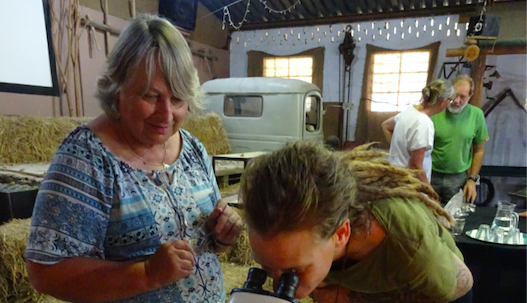by Marion Whitehead
Taking turns to peer down a microscope, members of Friends of Waters Meeting Nature
Reserve got a glimpse into how a special type of fungi runs the underground ‘internet’ that
allows plants of different species to connect and share nutrients and information.
‘Born to be friends’ was the title of the talk by Professor Joanna Dames of Rhodes University’s Department of Biochemistry and Microbiology at a 4 March meeting at Pike’s Post, beside the Ploughman Pub at the Bathurst Agricultural Museum.
The synergistic relationship between mycorrhizal fungi and plants that she revealed was a real eye-opener, demonstrating not just friendly sharing of water and micronutrients, but of functioning as a profound survival strategy for communities of diverse plants, helping them to fend off diseases and enhancing their ability to resist drought.
On their own, plants’ roots have limited reach. But the symbiotic relationship with the
mycorrhizal fungi, which coats and even enters the cells of the plants’ roots, form large
networks of filaments below the surface with a far greater reach. This acts as a very efficient
transport system, taking nutrients and moisture right into the plants’ roots.
Dames said that we promote this relationship when we garden organically, using compost and mulch. The outcome is stronger, healthier plants feeding on a broad underground network supplied by the mycorrhizae. However, when we till the soil, we break up these connections. Monoculture crops and commercial fertilisers are also anathema to the mycorrhizae.
“But there’s nothing for free,” quipped Dames. She explained that in return, the mycorrhizae fungi get carbon and sugars that the plant makes from photosynthesizing using its ‘solar panels’ (or leaves). “These nutrients are transported to the roots where they are exchanged with the fungi. Around 90 percent of our plants operate on this system. One centimetre of plant root can be associated with one metre of mycorrhizal threads under the ground” she said.
On specially prepared slides of root cells under the microscopes, members were able to see little balloons and hyphal threads stained blue. The smudgy blue areas where the nutrient exchange takes place are called arbuscules, explained Dames.
“The mycorrhizae form carbon bridges between a variety of plants. They don’t discriminate in this shared network, all plants benefit,” she said.
The popular talks held by Friends of Waters Meeting Nature Reserve take place at 10am on the first Saturday of the month at Pike’s Post at the Ploughman Pub in the grounds of the Bathurst Agricultural Museum.


